Abstract
1 Binding of propranolol in vitro was determined in sera from 38 non-fasting patients 4-6 days after an acute myocardial infarction. The binding of propranolol was significantly lower in 12 patients receiving a subcutaneous heparin injection than in 26 patients receiving warfarin.
2 The binding of propranolol in sera from 9 geriatric patients without any acute diseases and 10 young, healthy subjects was similar to that of patients with acute myocardial infarction receiving heparin.
3 Mean serum concentration of α1-acid glycoprotein was similar in the four different groups of individuals.
4 For all subjects, the binding of propranolol was positively correlated to serum concentrations of α1-acid glycoprotein.
5 In the patients with myocardial infarction the binding was negatively correlated to serum concentrations of non-esterified fatty acids. Mean serum concentrations of non-esterified fatty acids was significantly higher in the patients receiving heparin than those receiving warfarin.
6 Addition of heparin and palmitic acid to serum in vitro did not affect the binding of propranolol.
7 The effect of heparin on binding variations was observed more closely in three non-fasting patients with myocardial infarction. Serum binding of propranolol and concentrations of chylomicrons and pre-β-lipoproteins were significantly reduced after a subcutaneous heparin injection of 5,000 iu, while serum concentrations of non-esterified fatty acids increased threefold. Concentrations of α1-acid glycoprotein and albumin were unchanged. Changes in binding of propranolol was closely correlated to concomitant changes in the triglyceride-rich lipoproteins.
8 These observations indicate that propranolol is bound to both triglyceride-rich lipoproteins and α1-acid glycoprotein in serum. Even smaller doses of heparin activate lipoprotein lipase and decrease binding of propranolol to lipoproteins in non-fasting subjects.
Full text
PDF
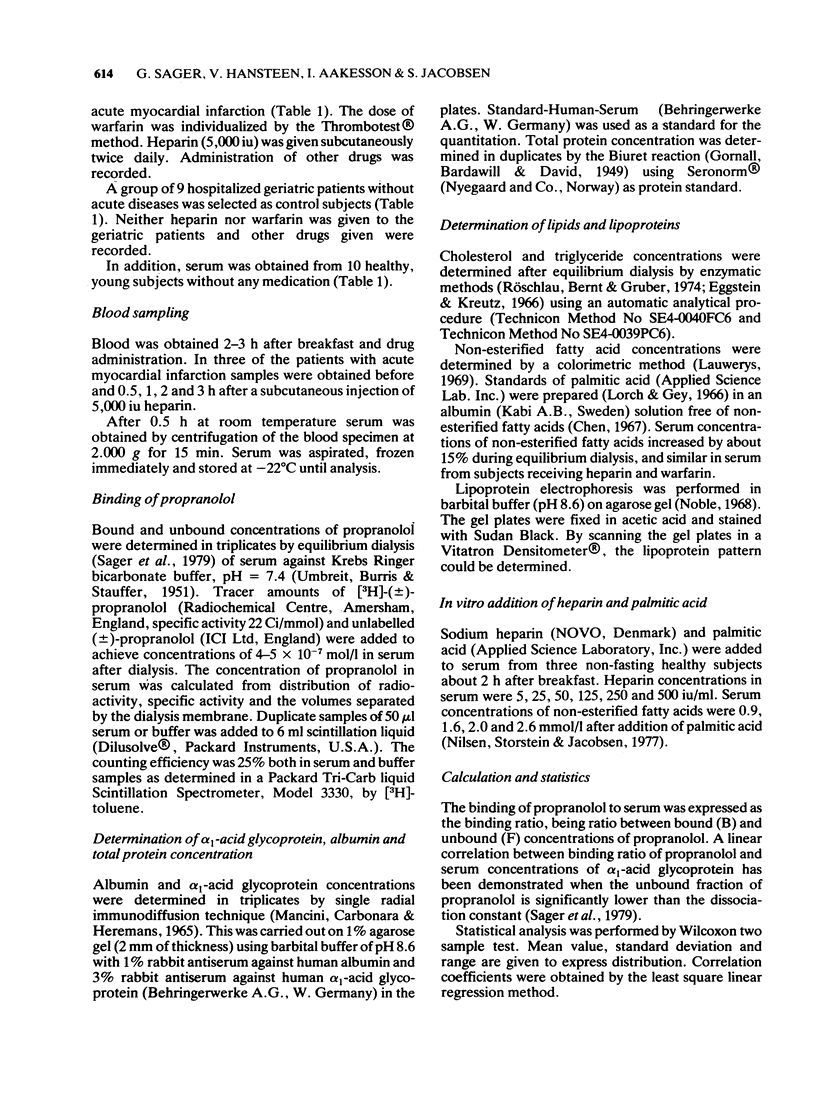
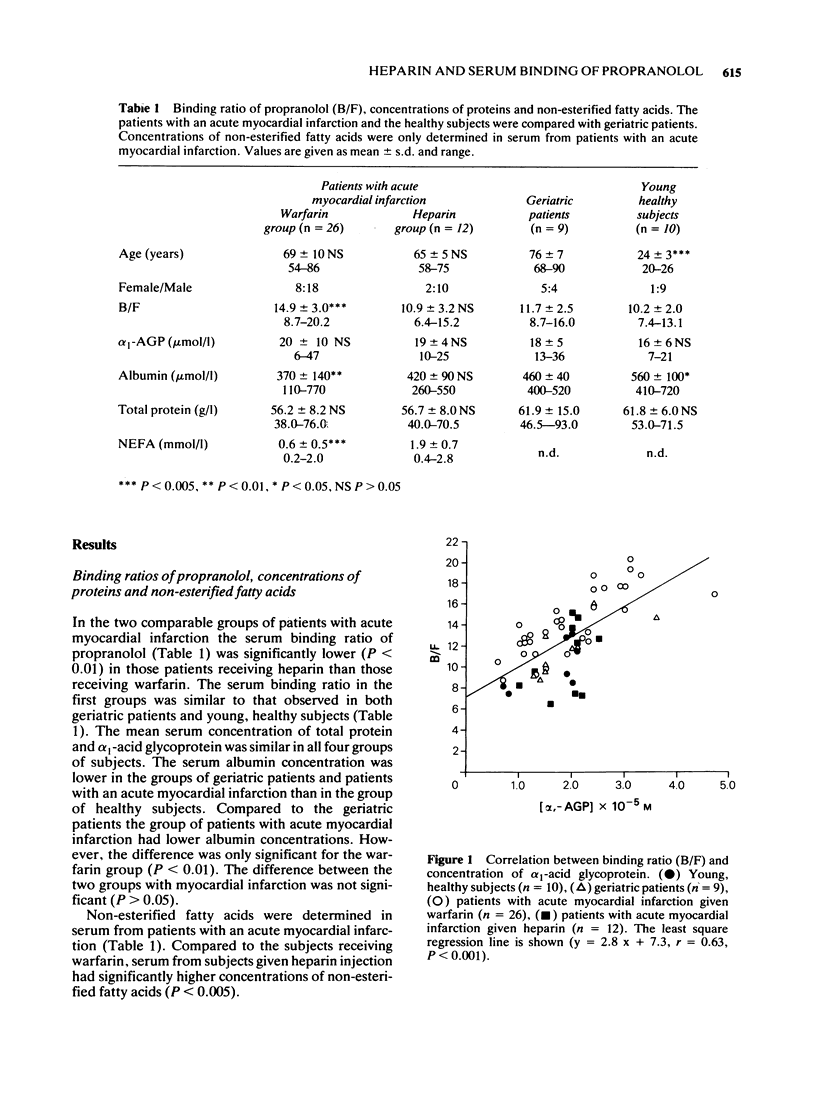
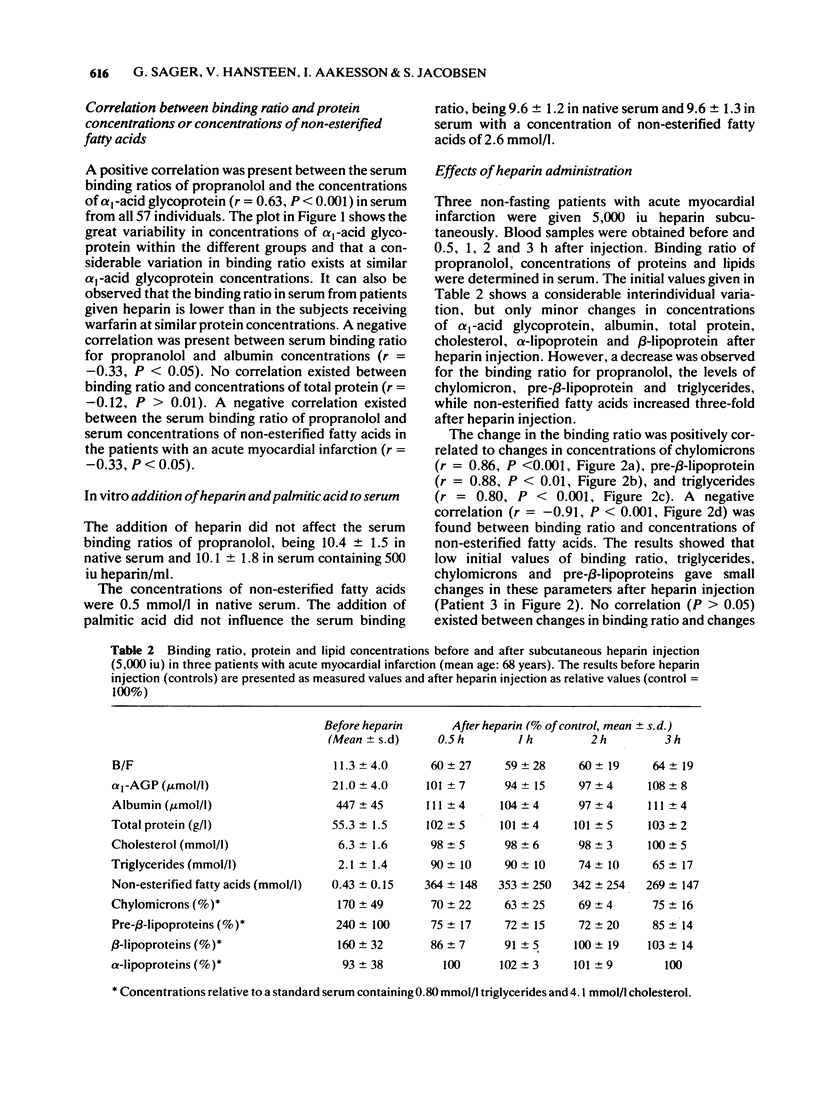
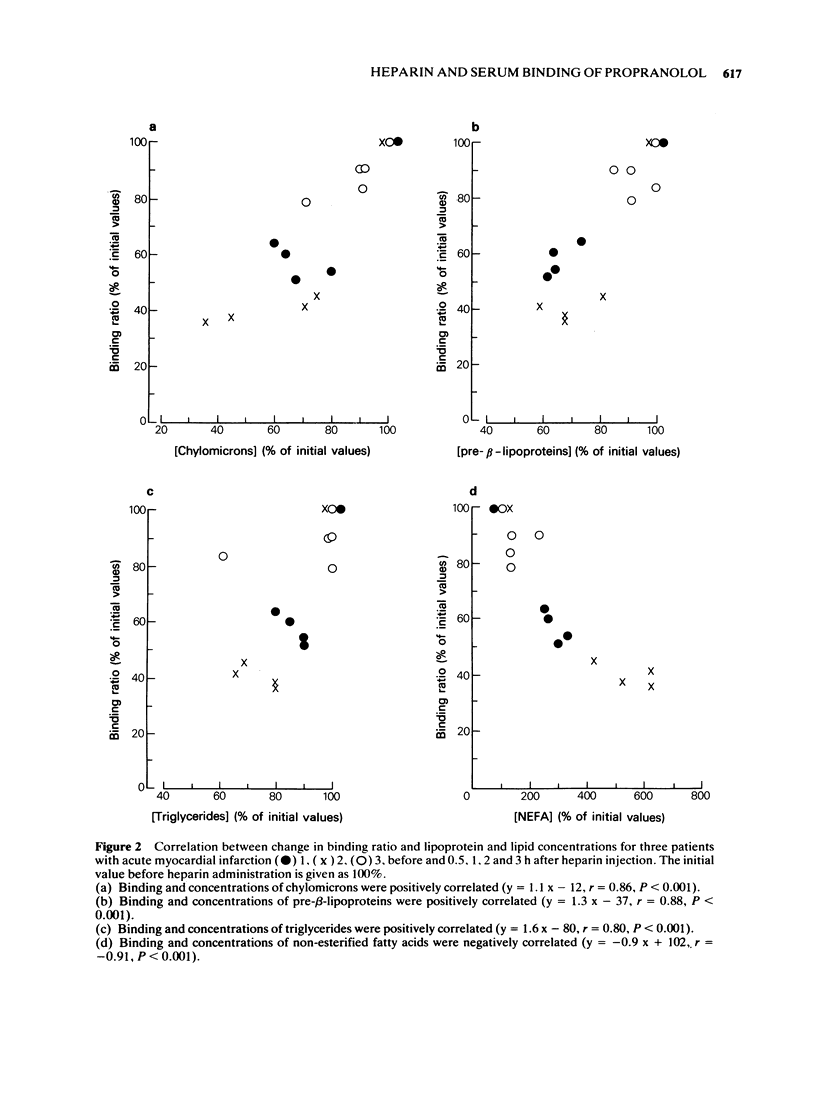
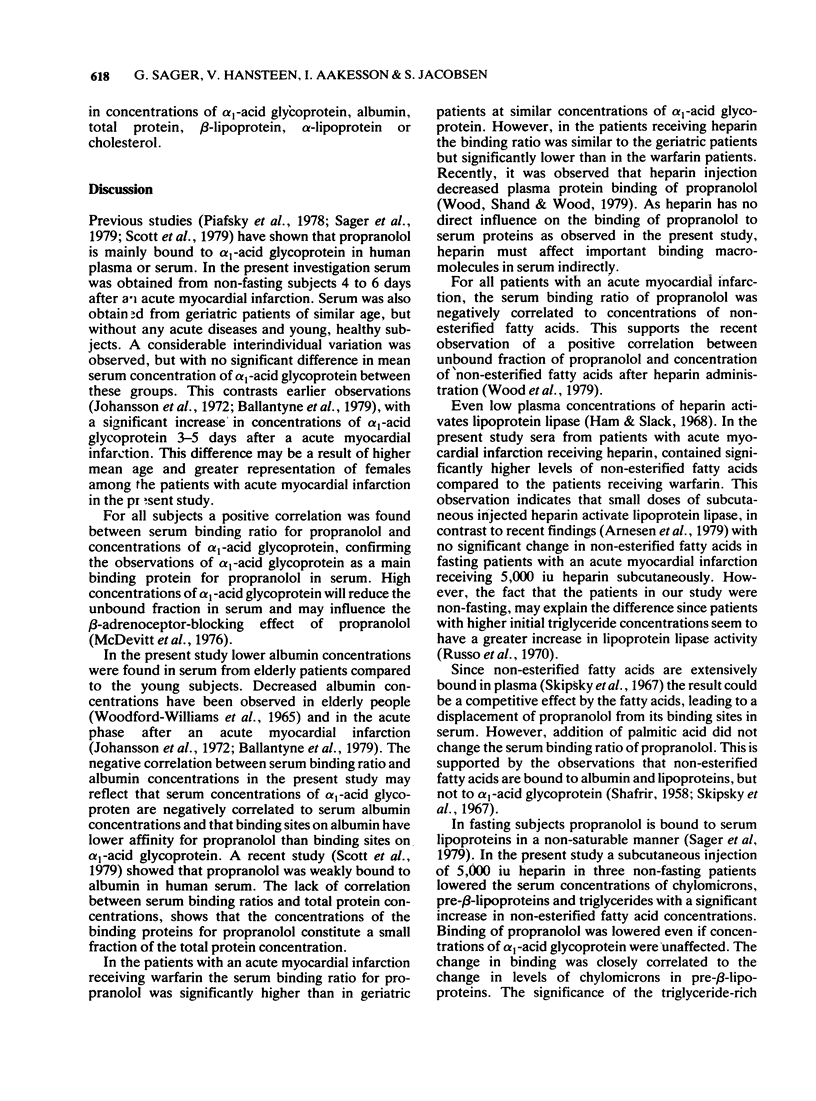
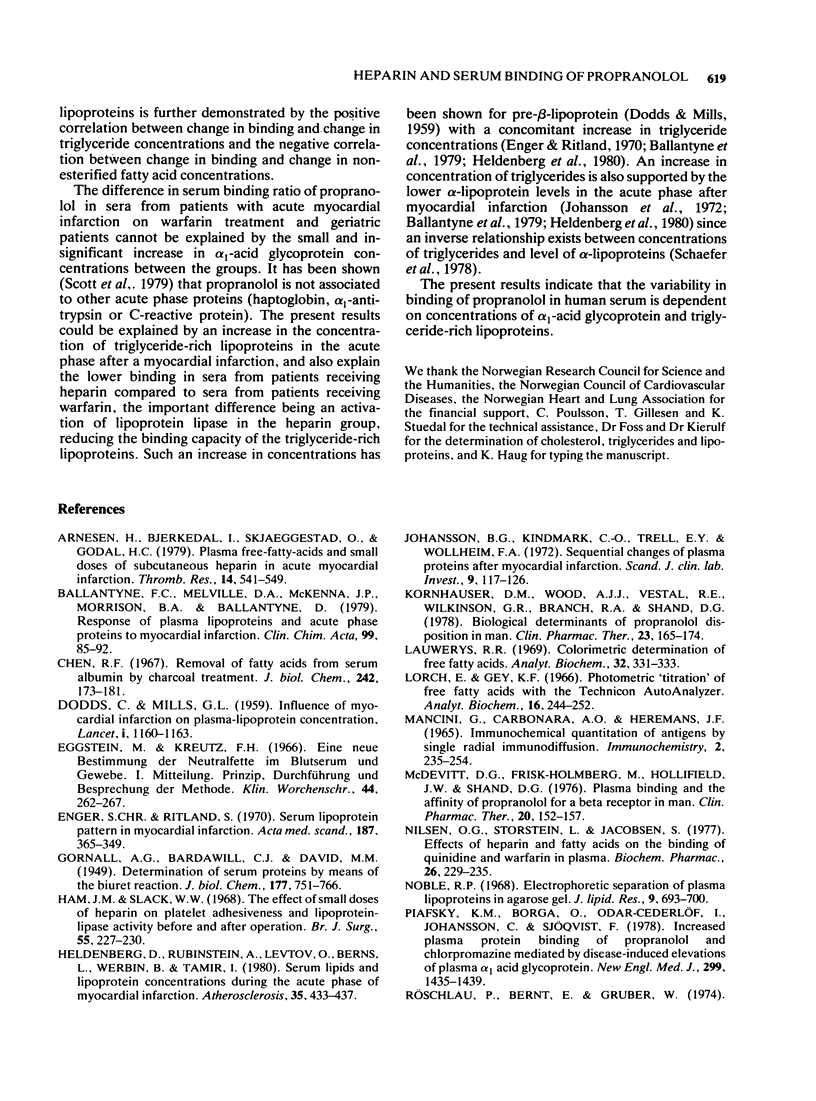
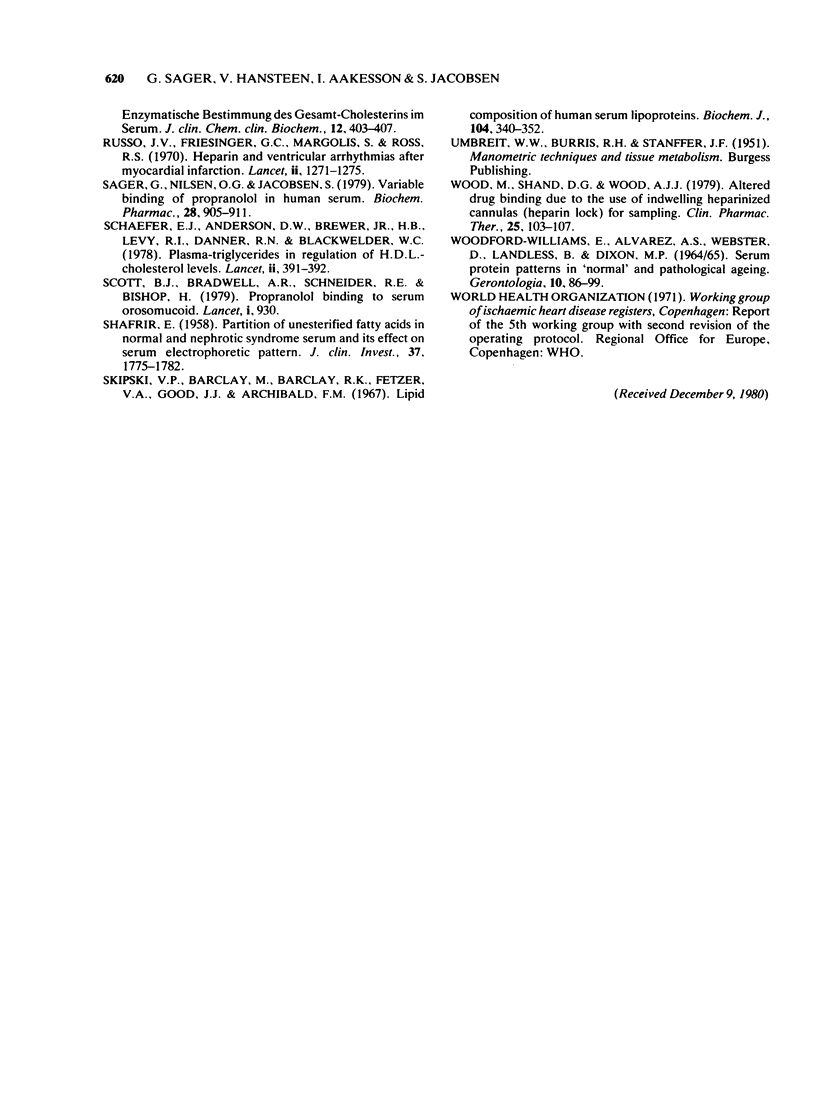
Selected References
These references are in PubMed. This may not be the complete list of references from this article.
- Arnesen H., Bjerkedal I., Skjaeggestad O., Godal H. C. Plasma free-fatty-acids and small doses of subcutaneous heparin in acute myocardial infarction. Thromb Res. 1979;14(4-5):541–549. doi: 10.1016/0049-3848(79)90110-5. [DOI] [PubMed] [Google Scholar]
- Ballantyne F. C., Melville D. A., McKenna J. P., Morrison B. A., Ballantyne D. Response of plasma lipoproteins and acute phase proteins to myocardial infarction. Clin Chim Acta. 1979 Nov 15;99(1):85–92. doi: 10.1016/0009-8981(79)90142-6. [DOI] [PubMed] [Google Scholar]
- Chen R. F. Removal of fatty acids from serum albumin by charcoal treatment. J Biol Chem. 1967 Jan 25;242(2):173–181. [PubMed] [Google Scholar]
- DODDS C., MILLS G. L. Influence of myocardial infarction on plasma-lipoprotein concentration. Lancet. 1959 Jun 6;1(7084):1160–1163. doi: 10.1016/s0140-6736(59)91178-x. [DOI] [PubMed] [Google Scholar]
- Eggstein M., Kreutz F. H. Eine neue Bestimmung der Neutralfette im Blutserum und Gewebe. I. Prinzip, Durchführung und Besprechung der Methode. Klin Wochenschr. 1966 Mar 1;44(5):262–267. doi: 10.1007/BF01747716. [DOI] [PubMed] [Google Scholar]
- Enger S. C., Ritland S. Serum lipoprotein pattern in myocardial infarction. Acta Med Scand. 1970 May;187(5):365–369. doi: 10.1111/j.0954-6820.1970.tb02957.x. [DOI] [PubMed] [Google Scholar]
- Ham J. M., Slack W. W. The effect of small doses of heparin on platelet adhesiveness and lipoprotein-lipase activity before and after operation. Br J Surg. 1968 Mar;55(3):227–230. doi: 10.1002/bjs.1800550316. [DOI] [PubMed] [Google Scholar]
- Heldenberg D., Rubinstein A., Levtov O., Berns L., Werbin B., Tamir I. Serum lipids and lipoprotein concentrations during the acute phase of myocardial infarction. Atherosclerosis. 1980 Apr;35(4):433–437. doi: 10.1016/0021-9150(80)90184-7. [DOI] [PubMed] [Google Scholar]
- Johansson B. G., Kindmark C. O., Trell E. Y., Wollheim F. A. Sequential changes of plasma proteins after myocardial infarction. Scand J Clin Lab Invest Suppl. 1972;124:117–126. doi: 10.3109/00365517209102759. [DOI] [PubMed] [Google Scholar]
- Kornhauser D. M., Wood A. J., Vestal R. E., Wilkinson G. R., Branch R. A., Shand D. G. Biological determinants of propranolol disposition in man. Clin Pharmacol Ther. 1978 Feb;23(2):165–174. doi: 10.1002/cpt1978232165. [DOI] [PubMed] [Google Scholar]
- Lauwerys R. R. Colorimetric determination of free fatty acids. Anal Biochem. 1969 Nov;32(2):331–333. doi: 10.1016/0003-2697(69)90093-1. [DOI] [PubMed] [Google Scholar]
- Lorch E., Gey K. F. Photometric "titration" of free fatty acids with the Technicon AutoAnalyzer. Anal Biochem. 1966 Aug;16(2):244–252. doi: 10.1016/0003-2697(66)90152-7. [DOI] [PubMed] [Google Scholar]
- Mancini G., Carbonara A. O., Heremans J. F. Immunochemical quantitation of antigens by single radial immunodiffusion. Immunochemistry. 1965 Sep;2(3):235–254. doi: 10.1016/0019-2791(65)90004-2. [DOI] [PubMed] [Google Scholar]
- McDevitt D. G., Frisk-Holmberg M., Hollifield J. W., Shand D. G. Plasma binding and the affinity of propranolol for a beta receptor in man. Clin Pharmacol Ther. 1976 Aug;20(2):152–157. doi: 10.1002/cpt1976202152. [DOI] [PubMed] [Google Scholar]
- Nilsen O. G., Storstein L., Jacobsen S. Effect of heparin and fatty acids on the binding of quinidine and warfarin in plasma. Biochem Pharmacol. 1977 Feb 1;26(3):229–235. doi: 10.1016/0006-2952(77)90308-2. [DOI] [PubMed] [Google Scholar]
- Noble R. P. Electrophoretic separation of plasma lipoproteins in agarose gel. J Lipid Res. 1968 Nov;9(6):693–700. [PubMed] [Google Scholar]
- Piafsky K. M., Borgá O., Odar-Cederlöf I., Johansson C., Sjöqvist F. Increased plasma protein binding of propranolol and chlorpromazine mediated by disease-induced elevations of plasma alpha1 acid glycoprotein. N Engl J Med. 1978 Dec 28;299(26):1435–1439. doi: 10.1056/NEJM197812282992604. [DOI] [PubMed] [Google Scholar]
- Russo J. V., Margolis S., Friesinger G. C., Ross R. S. Heparin and ventricular arrhythmias after myocardial infarction. Lancet. 1970 Dec 19;2(7686):1271–1275. doi: 10.1016/s0140-6736(70)92240-3. [DOI] [PubMed] [Google Scholar]
- Röschlau P., Bernt E., Gruber W. Enzymatische Bestimmung des Gesamt-Cholesterins im Serum. Z Klin Chem Klin Biochem. 1974 Sep;12(9):403–407. [PubMed] [Google Scholar]
- SHAFRIR E. Partition of unesterified fatty acids in normal and nephrotic syndrome serum and its effect on serum electrophoretic pattern. J Clin Invest. 1958 Dec;37(12):1775–1782. doi: 10.1172/JCI103770. [DOI] [PMC free article] [PubMed] [Google Scholar]
- Sager G., Nilsen O. G., Jacobsen S. Variable binding of propranolol in human serum. Biochem Pharmacol. 1979 Mar 15;28(6):905–911. doi: 10.1016/0006-2952(79)90374-5. [DOI] [PubMed] [Google Scholar]
- Schaefer E. J., Levy R. I., Anderson D. W., Danner R. N., Brewer H. B., Jr, Blackwelder W. C. Plasma-triglycerides in regulation of H.D.L.-cholesterol levels. Lancet. 1978 Aug 19;2(8086):391–393. doi: 10.1016/s0140-6736(78)91863-9. [DOI] [PubMed] [Google Scholar]
- Scott B. J., Bradwell A. R., Schneider R. E., Bishop H. Propranolol binding to serum orosomucoid. Lancet. 1979 Apr 28;1(8122):930–930. doi: 10.1016/s0140-6736(79)91415-6. [DOI] [PubMed] [Google Scholar]
- Skipski V. P., Barclay M., Barclay R. K., Fetzer V. A., Good J. J., Archibald F. M. Lipid composition of human serum lipoproteins. Biochem J. 1967 Aug;104(2):340–352. doi: 10.1042/bj1040340. [DOI] [PMC free article] [PubMed] [Google Scholar]
- Wood M., Shand D. G., Wood A. J. Altered drug binding due to the use of indwelling heparinized cannulas (heparin lock) for sampling. Clin Pharmacol Ther. 1979 Jan;25(1):103–107. doi: 10.1002/cpt1979251103. [DOI] [PubMed] [Google Scholar]


